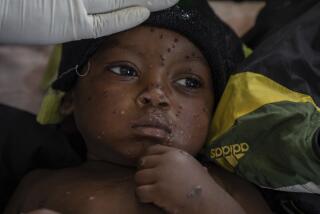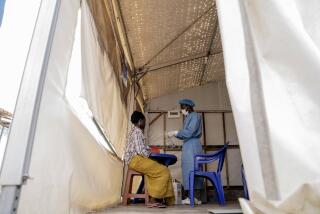Fiery Death Awaits Last Remaining Samples of Deadly Smallpox Virus : Medicine: Stocks of the feared pathogen are secured in freezers in Russia, U.S. They are to be simultaneously destroyed next year, exterminating a species.
- Share via
ATLANTA — There will be no last-minute reprieve for smallpox, no candlelight protest of supporters outside its guarded prison.
A scourge of humanity for more than 3,500 years, smallpox has just eight months to live before it is burned like a medieval witch.
Death will come early on June 30 as scientists, dignitaries and public health officials in Atlanta and Russia oversee the first deliberate destruction of a species so vile it has been called “Spotted Death” and “The Great Fire.”
The execution date was set in September by a panel of scientists with the World Health Organization who believe that, if the smallpox virus somehow escaped, it could wreak havoc on an unvaccinated world.
Some researchers object to deliberately destroying an entire species of virus, particularly one that might teach them how to fight other diseases. But scientists have produced harmless clones of DNA fragments of the smallpox virus and are satisfied they have the full genetic blueprint.
Few, other than researchers interested in smallpox, will mourn the loss of the virus.
“The only reason one might be concerned would be losing a biological species from the Earth deliberately,” said Dr. Brian Mahy of the federal Centers for Disease Control and Prevention. “I can see the argument whether man has the right to protect his species from another. To wipe out a species is always a concern.”
The death sentence affects all of the known remaining stocks of smallpox, about 400 samples locked in special freezers at the CDC in Atlanta and another 200 or so at Russia’s State Research Center of Virology and Biotechnology.
Smallpox killed up to 600,000 people a year in Europe from the 16th Century through the 18th Century. A vaccine was discovered in the 1790s, but it took nearly 200 years of immunizations to wipe smallpox out.
The virus’s own lifestyle played a large role in the success of a worldwide effort to eradicate it within three decades.
“The virus has a remarkable propensity to spread from human to human,” Mahy said. “It’s a virus that can be spread by . . . a blanket from a person with lesions to another person.
“The problem the virus had was that it had only one host--which was a human. Viruses which have only a single host . . . in theory are eradicable, because it’s possible to eradicate all of the virus from humans and then the virus gets lost from the world.”
All it takes is a government-issued autoclave to kill smallpox forever, a process that will take two hours, according to guidelines developed by WHO. New equipment will not be purchased, Mahy said.
“We autoclave masses of glassware, tubes of various types, in order to sterilize it,” said Mahy, who will help oversee smallpox’s destruction.
Smallpox will spend its last minutes alongside plates of sturdy bacteria, whose death will confirm that smallpox is no more.
The execution will be watched by officials at both labs via satellite, and it probably will be videotaped. Those present will be vaccinated against the dreaded illness.
The CDC’s stock is kept in a liquid nitrogen freezer in Room 318B in a maximum-security laboratory building near the Emory University campus. The last civilian to see the room, a reporter for the London Times, said in 1991 that the samples were kept in a silvery blue freezer that is chained, padlocked and wrapped with yards of duct tape.
Under elaborate security measures--the CDC won’t give exact details--the virus will be taken from the freezer to the autoclave.
The researchers will wear pressurized spacesuits as they pass the test tubes into a large autoclave built into the wall.
The autoclave will automatically heat up to 266 degrees Fahrenheit for 40 minutes and then repeat the process. Its cycle cannot be stopped. When the cycle is complete, scientists will remove the incinerated smallpox samples and bacteria from the back of the machine, and their deaths will be confirmed.
“It’s extremely encouraging from a public health point of view that it’s so simple to kill smallpox,” Mahy said.
The last case of naturally occurring smallpox was in Somalia in 1977. Experts have recommended since 1986 that the virus be eliminated to prevent its accidental release or its use as a biological weapon.
Recent advances in gene sequencing bolstered that argument. CDC researchers have now mapped three strains of the smallpox virus, creating a library of information that once would have been available only from the virus itself.
The decision to rid the world of smallpox has not received final approval, but it is mostly just a formality. The final sentence will come in May at a meeting of WHO’s full assembly of 180 countries.
The WHO panel that recommended smallpox’s destruction has also suggested that 500,000 doses of smallpox vaccine be kept on hand for emergencies, should the virus crop up from an unknown source.






